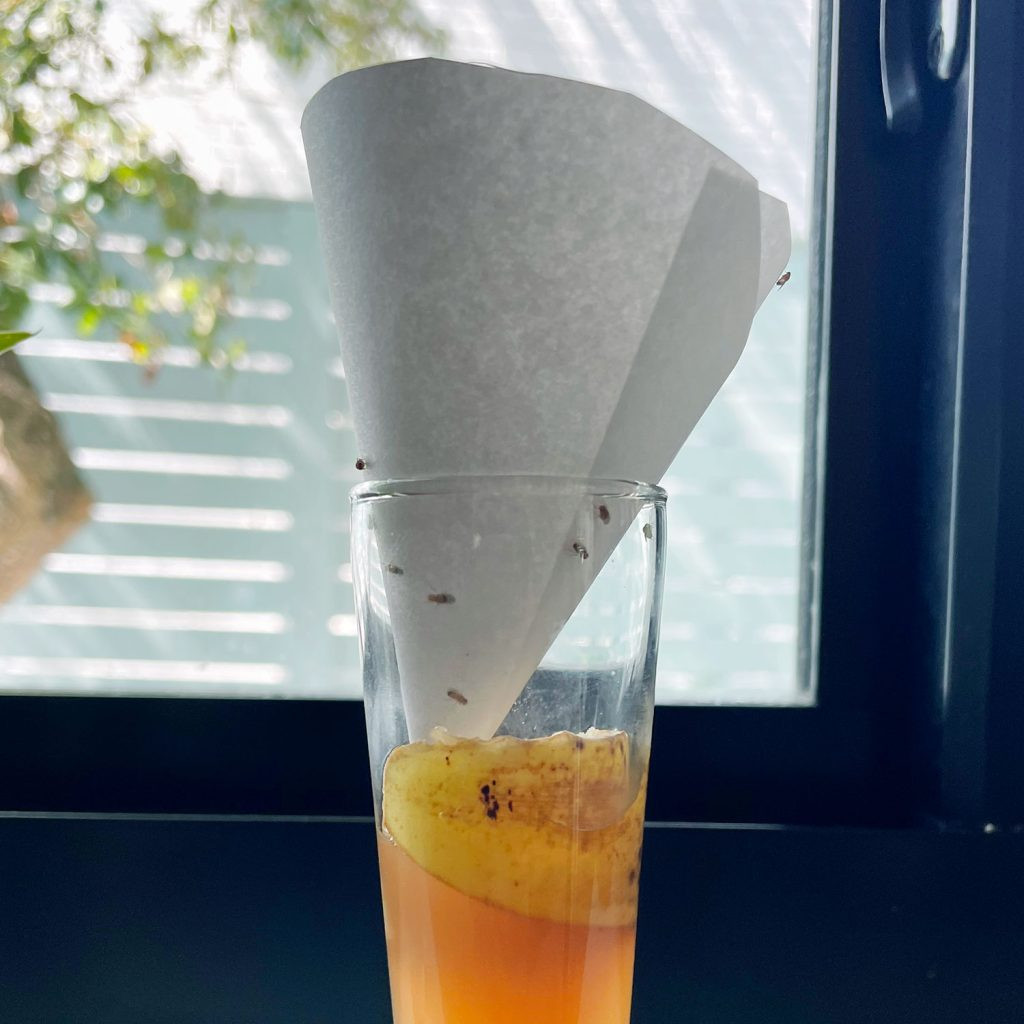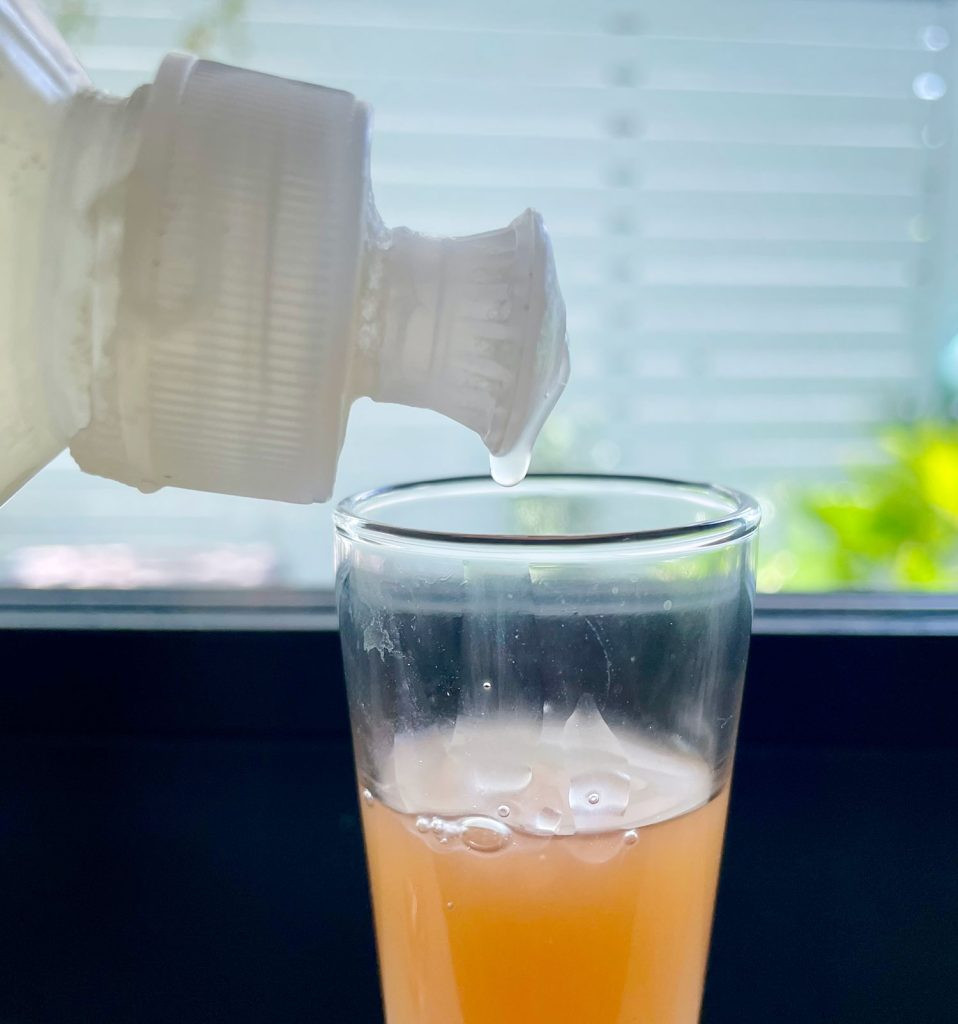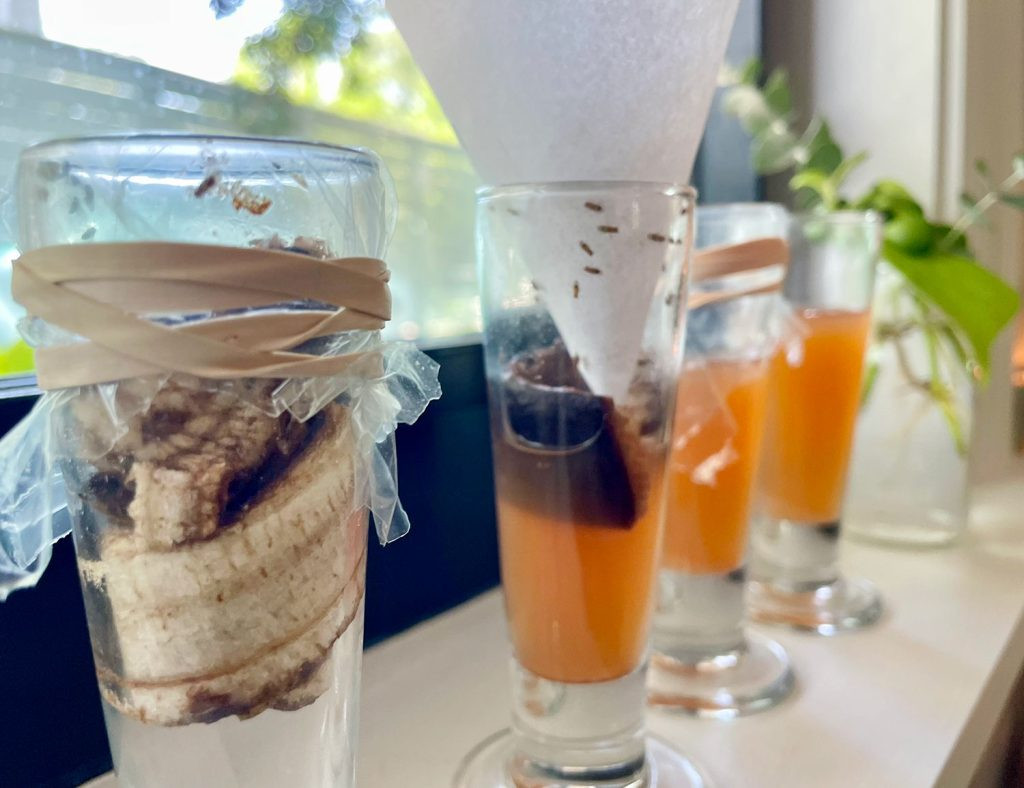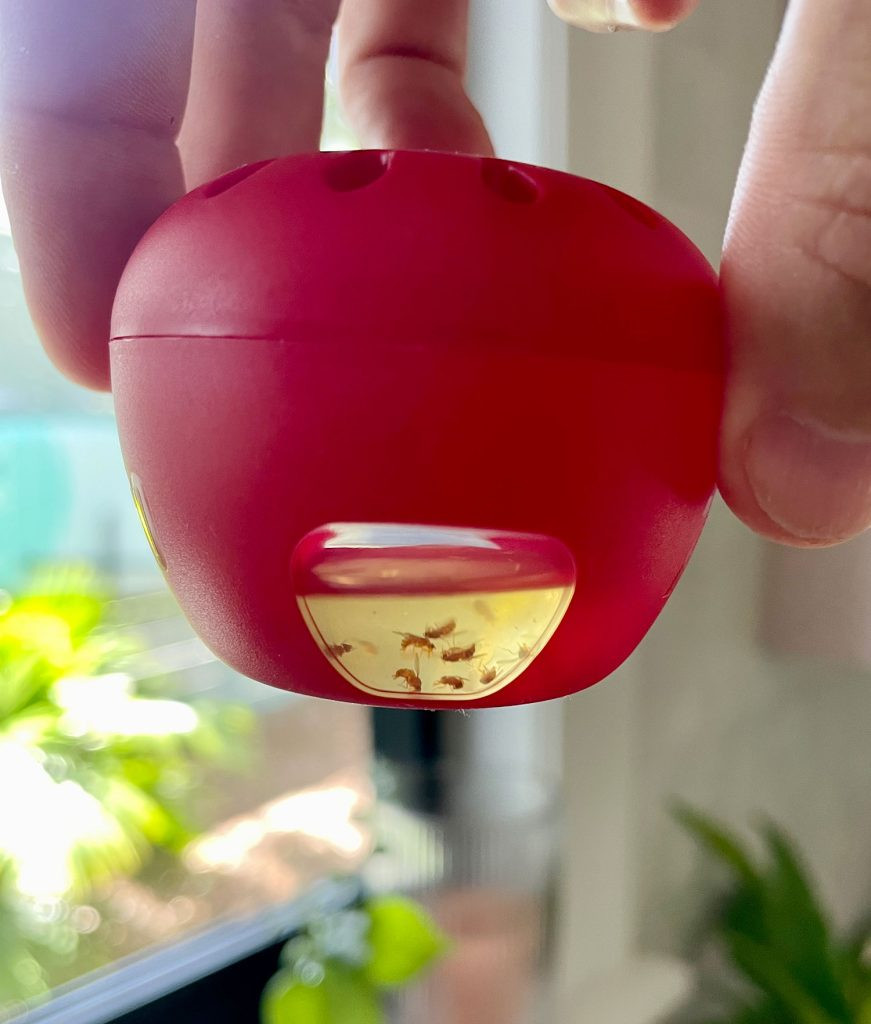Are tiny flies buzzing around your fruit bowl or hovering near your kitchen sink? You’re likely dealing with fruit flies. These common household pests can be a nuisance, but thankfully, eliminating them is easier than you might think. You don’t need harsh chemicals or expensive gadgets – simple, do-it-yourself methods using items you probably already have at home can effectively solve your fruit fly problem.
Just like many homeowners, we recently experienced a fruit fly invasion in our kitchen. To tackle this issue head-on, we decided to put various remedies to the test. After experimenting with multiple approaches and meticulously documenting the results, we’re excited to share the most effective DIY fruit fly traps you can easily create. These traps utilize natural ingredients and are incredibly simple to assemble, making them both budget-friendly and eco-conscious. If you’re feeling compassionate, we’ll also explore humane options to release these tiny invaders back outside. Beyond traps, we’ll also cover essential preventative measures to keep your home fruit fly-free in the long run.
What Exactly Are Fruit Flies?
Fruit flies are small, winged insects that are strongly attracted to ripe or fermenting fruits and vegetables – hence their name. Beyond fruit, they are also drawn to sugary substances like spilled juice, wine, beer, and even sugary residues in garbage disposals and trash cans. You’ll often find them congregating around fruit bowls, garbage areas, drains, and anywhere there’s a hint of sweetness or decay.
These tiny pests are typically around the size of a grain of rice and have a tan or brownish color, resembling small houseflies, often with distinctive red eyes. Fruit flies are most prevalent during warmer months, especially in late summer and fall when fruits are abundant and ripening.
A fruit fly infestation often begins subtly. Just a few fruit flies might hitch a ride into your home on fruits or vegetables from the grocery store. However, their rapid reproduction cycle means a small initial presence can quickly escalate into a major problem. Female fruit flies can lay hundreds of eggs in their short lifespan, and these eggs can hatch in as little as 12 hours. The larvae mature into adults within a few days, leading to exponential population growth. This rapid breeding is why prompt action is crucial to get rid of fruit flies before they truly take over.
Identifying Fruit Flies: Fruit Flies vs. Fungus Gnats vs. Drain Flies
It’s easy to mistake fruit flies for other small flying insects commonly found indoors, particularly fungus gnats and drain flies. Accurate identification is key because different pests might require slightly different control methods. The easiest way to distinguish them is by observing where you see them and noting what larger insect they resemble.
- Fruit Flies: Resemble small flies and are typically seen near fruit bowls, garbage cans, pantries, or any exposed food sources.
- Drain Flies: Look like small, fuzzy moths. As their name suggests, they are usually found hovering around sinks, drains, and damp areas.
- Fungus Gnats: Appear similar to small mosquitoes. They are most often seen near houseplants, as they breed in moist potting soil.
If you’re still unsure about the type of pest you’re dealing with, trying one of the DIY traps outlined below is a simple diagnostic test. If the trap attracts the insects in your home, you can confidently identify them as fruit flies and proceed with targeted elimination strategies.
4 Simple DIY Fruit Fly Traps You Can Make Now
Getting rid of fruit flies doesn’t require complicated procedures or expensive products. The core principle behind effective fruit fly traps is simple: attract the flies into a confined space and then prevent their escape. We tested four different DIY trap methods, and while one emerged as a clear winner in our experiment, all of them utilize common household items and are worth trying. Consider experimenting with a couple of different traps to see what works best in your situation – think of it as a mini fruit fly science project! Remember that some traps work more quickly than others, and it might take a few days to completely eliminate a fruit fly infestation, so patience is key. Here are four easy DIY fruit fly traps we tested:
- Funnel Trap
- Plastic Wrap Trap
- Dish Soap Trap
- Rotting Fruit Trap
Let’s delve into the details of each method, including step-by-step instructions and our findings on their effectiveness.
#1: The Paper Funnel Fruit Fly Trap
This trap uses a paper funnel to guide fruit flies into a container baited with an attractant. The narrow opening of the funnel makes it easy for flies to enter but difficult to exit, effectively trapping them inside.
 DIY Fruit Fly Trap With Paper Funnel
DIY Fruit Fly Trap With Paper Funnel
Supplies you’ll need:
- A small, clear jar, cup, or container – a narrow opening is beneficial.
- A piece of paper or cardstock.
- Tape.
- Scissors.
- Apple cider vinegar (ACV).
Step-by-step instructions:
- Choose your container: Select a small, transparent container like a mason jar, empty food jar, or plastic bottle. Clear containers allow you to monitor your trap’s success. A narrow opening helps prevent fly escape.
- Add the attractant: Pour a small amount of apple cider vinegar, old beer, or wine into the bottom of the container. The sweet, fermented scent acts as a powerful lure for fruit flies.
- Create the paper funnel: Take a piece of paper or cardstock and roll it into a cone shape. The cone should have a very small opening at the narrow end, about the size of a grain of rice. Secure the cone shape with tape. You can create the small opening by cutting the tip after forming the cone if that’s easier.
- Position the funnel: Place the paper funnel into the opening of your container, with the narrow tip pointing down towards the liquid. Adjust the funnel so it rests securely on the rim of the container, ensuring there are no gaps for flies to escape around the edges. The funnel should be positioned just above the liquid, not submerged.
- Humane Release (Optional): If you prefer a humane approach, carefully carry the trap outdoors without disturbing the funnel (to prevent flies from escaping). Once outside, remove the funnel to allow the trapped fruit flies to fly away.
While store-bought funnels could technically be used, their openings are often too wide, which might allow trapped fruit flies to escape more easily. Homemade paper funnels offer better control over the opening size.
#2: The Plastic Wrap Fruit Fly Trap
Similar to the funnel trap, the plastic wrap trap utilizes apple cider vinegar to attract fruit flies. Flies enter through tiny holes poked in the plastic wrap stretched over the container opening but struggle to find their way back out.
Materials required:
- Small, clear jar, cup, or container.
- Rubber band.
- Plastic wrap or a plastic bag.
- Toothpick.
- Apple cider vinegar (ACV).
Easy steps to assemble:
- Select your container: Choose a small, clear container. Transparency is helpful for monitoring trap effectiveness. While clear containers are ideal, even opaque options like old cans can work.
- Pour in the lure: Add apple cider vinegar to the container. Again, the enticing scent will attract the fruit flies. Old beer or wine also work effectively. Avoid using regular white vinegar, as it’s not as attractive to fruit flies.
- Cover the opening: Stretch plastic wrap tightly over the opening of the container and secure it firmly with a rubber band. Make sure the plastic wrap is taut and creates a sealed surface. You can use standard kitchen plastic wrap or even cut a piece from a plastic bag.
- Create entry holes: Use a toothpick to gently poke a few small holes in the plastic wrap surface. These holes should be just large enough for fruit flies to enter. You don’t need to create many holes – a few well-placed punctures are sufficient.
- Humane Release (Optional): To release the trapped flies humanely, carefully take the trap outside, ensuring the plastic wrap remains in place. Once outdoors, remove the plastic wrap to allow the fruit flies to escape.
Alternatively, you can adapt this method using a jar with a metal lid. Puncture a small hole in the metal lid using a hammer and nail, creating a more durable and reusable trap. Mason jars or repurposed food jars with metal lids are excellent choices for this variation.
#3: The Simple Dish Soap Fruit Fly Trap
This trap differs from the previous two as it doesn’t require a cover. Instead, it relies on the properties of dish soap to trap fruit flies. Important note: this method is not designed for humane release as the soap will coat the flies.
 Dripping Dish Soap Into Apple Cider Vinegar For DIY Fruit Fly Trap
Dripping Dish Soap Into Apple Cider Vinegar For DIY Fruit Fly Trap
You will need:
- A small container, bowl, or dish.
- Dish soap.
- Apple cider vinegar (ACV).
Crazy simple steps:
- Pour in the attractant: Fill the bottom of your chosen container (bowl, dish, or jar) with apple cider vinegar. The scent of ACV will draw the fruit flies in.
- Add dish soap: Add several drops of liquid dish soap to the apple cider vinegar. Gently stir to mix the soap into the vinegar solution. The dish soap reduces the surface tension of the vinegar, so when fruit flies land on the surface, they get trapped and sink instead of being able to fly away.
This dish soap method can also be combined with the plastic wrap or funnel traps for enhanced effectiveness. Simply add a few drops of dish soap to the apple cider vinegar before covering the container with plastic wrap or inserting the funnel. This adds an extra trapping mechanism to those designs.
#4: The Rotting Fruit Bait Trap
Fruit flies are naturally attracted to overripe and rotting fruit. This trap leverages that attraction by using actual fruit as bait instead of apple cider vinegar.
Supplies needed:
- Small glass jar, cup, or container.
- Plastic wrap or paper funnel (depending on your chosen trap style).
- A small piece of ripe or overripe fruit, such as banana peel or apple slice.
To create a rotting fruit trap, simply replace the apple cider vinegar in either the Plastic Wrap Trap or Funnel Trap with a piece of banana peel, apple slice, peach, or other soft, ripe fruit. You can also enhance the attractiveness of the trap by adding a piece of fruit to apple cider vinegar. Be mindful that fruit will decompose and may produce odors over time, so you’ll need to replace the fruit bait every day or two to maintain effectiveness and prevent unpleasant smells in your kitchen.
Finding the Best DIY Fruit Fly Trap: Our Experiment Results
To determine the most effective DIY trap, we conducted a side-by-side comparison of four different homemade trap variations. Our tested traps were:
- Plastic Wrap Trap with banana peel
- Funnel Trap with ACV + banana peel
- Plastic Wrap Trap with ACV + dish soap
- Dish Soap Trap with ACV
 4 DIY Fruit Fly Traps Close Up
4 DIY Fruit Fly Traps Close Up
Our results indicated that the type of lure used was more significant than the trap design itself. Traps baited with banana peel consistently outperformed those using only apple cider vinegar. In fact, our two Plastic Wrap Traps were virtually identical in design, but the one containing banana peel captured significantly more fruit flies than the ACV and soap trap. This suggests that while apple cider vinegar is effective, real fruit is even more enticing to fruit flies.
Therefore, our recommendation is to incorporate a piece of fruit scrap into any DIY fruit fly trap you choose to set up. While we observed a slight preference for the plastic wrap trap due to its ease of construction and stability (less prone to accidental spills), the key to success lies in the bait. During our testing, we did accidentally knock over a funnel trap, releasing some trapped flies back into the kitchen – a minor mishap highlighting the plastic wrap trap’s slightly more secure design.
What’s the Most Effective Fruit Fly Attractant? Further Testing
Our initial experiment clearly demonstrated the power of fruit as a lure. Intrigued by these findings, we decided to delve deeper and investigate which type of fruit is the most irresistible to fruit flies. We tested three readily available fruits: banana peel, apple slices, and a strawberry. Each fruit was placed in a separate Plastic Wrap Trap, and we positioned them side-by-side on our countertop for a 24-hour period.
While the banana peel initially appeared promising due to its strong aroma, the results showed that strawberries were the most effective attractant. Although banana peel still captured a good number of fruit flies, the strawberry trap consistently caught more flies, especially as the strawberry became riper. Interestingly, the apple slices failed to attract a single fruit fly in our test!
Store-Bought Fruit Fly Trap Options
If DIY methods aren’t working for you, or if you prefer a ready-made solution, numerous commercially available fruit fly traps are on the market. Many of these traps have garnered thousands of positive reviews and are generally affordable, typically costing under $20. Store-bought traps might be a good option if you want a trap that targets a broader range of flying insects or if you desire a more discreet trap design compared to homemade versions.
 Collage of Storebought Fruit Fly Traps
Collage of Storebought Fruit Fly Traps
During our fruit fly trap experiment, we purchased a pack of Terro Fruit Fly Traps to compare their performance against our DIY traps. We placed a Terro trap alongside our homemade banana and strawberry traps for 24 hours to see which performed best.
Again, our homemade strawberry trap proved to be the most effective, closely followed by the banana peel trap. The store-bought Terro trap only caught a single fruit fly in this initial 24-hour period. HOWEVER…
 Terro Fruit Fly Trap With Dead Fruit Flies Visible
Terro Fruit Fly Trap With Dead Fruit Flies Visible
To ensure a fair assessment, we discarded our DIY traps and left the Terro trap in place for another 24 hours. Over this extended period, the Terro trap effectively captured a significant number of fruit flies, as shown in the photo above. So, while store-bought traps do work, they might not be as immediately effective or rapid-acting as homemade traps, particularly those baited with fruit. Our conclusion? Store-bought traps are a good choice if you prioritize discreetness and prefer a long-term solution, but for fast and highly effective fruit fly removal, DIY traps, especially fruit-baited ones, are hard to beat!
Preventing Fruit Flies: Long-Term Strategies
While eliminating existing fruit flies is important, preventing future infestations is the most sustainable approach. Here are simple preventative steps to minimize fruit fly problems in your home:
- Maintain clean kitchen surfaces: Regularly wipe down kitchen counters, stovetops, tables, and any surfaces prone to food residue or spills. Fruit flies are strongly attracted to sugary substances, fruit juices, and alcohol, so prompt cleanup is key.
- Take out trash frequently: Food scraps left in your garbage, especially overnight, can rapidly become a breeding ground for fruit flies. Empty kitchen trash cans daily to eliminate potential food sources.
- Dispose of overripe fruit promptly: Monitor your fruit bowl for signs of overripening or rotting fruit (e.g., browning bananas, soft apples). Discard overripe fruit immediately to prevent attracting fruit flies.
- Wash produce upon bringing it home: Washing fruits and vegetables as soon as you get them home from the grocery store can help remove any fruit fly eggs or larvae that might be present on the surface. (Note: Berries are an exception, as washing them too soon can accelerate spoilage. Wash berries just before consuming).
- Store produce in the refrigerator when possible: Fruit flies thrive in warmer temperatures and are less active in the cold. Refrigerating fruits and vegetables, especially ripe ones, can significantly deter fruit flies.
- Clean your sink drain regularly: Food particles and organic matter accumulating in sink drains can attract fruit flies. Run your garbage disposal frequently and flush drains with hot water or a drain cleaner periodically to eliminate potential breeding sites.
Finally, remember that discovering fruit flies in your home is a common occurrence and not a cause for panic. While swift action is advisable to prevent the problem from escalating, the solutions outlined in this guide are easy to implement, effective, and fast-acting. You might even find yourself enjoying the process of becoming a fruit fly scientist, just like we did!
*This post contains affiliate links, so we may earn a small commission when you make a purchase through links on our site at no additional cost to you.
